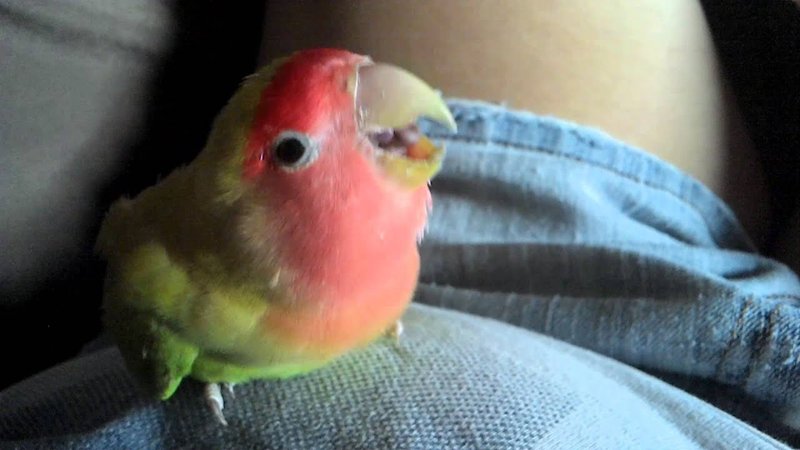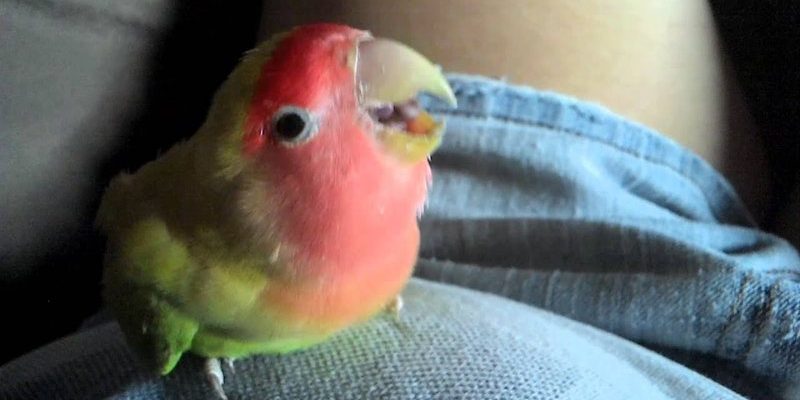
Let’s dive into these behaviors and understand what they mean. Understanding your feathered friend’s quirks can make a huge difference in how you interact and bond with them. Think of this as your friendly guide to navigating the ups and downs of lovebird behavior.
Why Do Lovebirds Bite?
Biting might seem like a strange way for a lovebird to express itself, but it’s often a form of communication. If you’ve ever been startled by a little beak catching you off guard, you’re not alone. Lovebirds might bite out of fear, frustration, or even to establish dominance. Here’s the thing: they don’t usually bite out of malice. Instead, they might be telling you, “I need space!” or “I’m feeling a bit overwhelmed!”
If your lovebird bites when you try to pick it up, it could be a sign that it’s not yet comfortable with handling. Consider these tips to minimize biting:
- Give your bird time to adjust to its new environment.
- Always approach your lovebird slowly and calmly to avoid startling it.
- Use treats to encourage positive behavior—this builds trust.
Patience is key when it comes to training your feathered friend. Remember, consistent handling and gentle interactions can help a lovebird feel more secure, ultimately reducing those unexpected bites.
Understanding Lovebird Screaming
Screaming is another common behavioral issue that many lovebird owners face. These birds are naturally vocal, but their loud calls can sometimes test the limits of your patience. You might be wondering, “Why does my lovebird scream so much?” Well, there are several reasons behind this behavior.
Firstly, lovebirds are social creatures. In the wild, they communicate with each other through calls and sounds. If they feel lonely or bored, they might resort to loud screeching to express their discomfort. This could mean they need more social interaction or mental stimulation.
Here are some ways to help curb excessive screaming:
- Spend quality time engaging with your lovebird daily—play games or teach it tricks.
- Provide toys or puzzles to keep your bird busy when you’re not around.
- Consider introducing another lovebird to keep your feathered friend company.
Ultimately, addressing screaming involves understanding the underlying reasons and providing a fulfilling environment for your lovebird.
Identifying Stress Triggers
Stress can often lead to both biting and screaming in lovebirds. Just like humans, birds can feel anxious or intimidated by changes in their environment. A noisy household, sudden movements, or the presence of predators can trigger stress. If you notice your lovebird is more nippy or vocal during certain times, it might be reacting to something in its surroundings.
To help your lovebird feel secure, try to identify what’s causing its stress. Here are some tips:
- Keep the cage in a quiet area of your home, away from loud noises.
- Avoid sudden movements around your lovebird, especially when it’s perched outside the cage.
- Provide a cozy, safe space where your bird can retreat when it feels overwhelmed.
Creating a tranquil environment is essential for your lovebird’s well-being. When they feel safe, you’ll likely see less biting and hear fewer screams.
The Importance of Socialization
Lovebirds thrive on social interactions, so it’s essential to engage with them regularly. If they don’t receive enough attention, they may resort to screaming to grab your attention or biting as a means of communication. Consider the saying, “A happy bird is a quiet bird.” The more time you spend with your lovebird, the less likely it’ll feel the need to make its presence known through noise or nips.
To enhance socialization, try:
- Talking to your lovebird daily. They love the sound of your voice!
- Offering hands-on playtime, allowing them to explore outside the cage safely.
- Utilizing positive reinforcement when they exhibit calm behavior.
Socializing not only strengthens your bond but also helps your lovebird feel more relaxed and secure.
Training and Behavior Modification
If your lovebird’s biting and screaming become ongoing issues, training can be incredibly beneficial. Much like teaching a child proper behavior, birds can learn what’s acceptable through consistent reinforcement. One effective technique is to reward good behavior rather than punishing bad behavior.
Consider these strategies for training your lovebird:
- Use a clicker or verbal cue to mark good behaviors, followed by a treat.
- Be consistent in your training sessions—short, frequent sessions work best.
- Always remain calm and avoid yelling or displaying frustration when correcting behaviors.
Training takes time, but it’s worth the effort. With patience and consistency, you can help your lovebird develop positive behaviors.
When to Seek Professional Help
If you’ve tried various techniques to manage biting and screaming but nothing seems to work, it might be time to consult a professional. An avian vet or a bird behaviorist can provide expert advice tailored to your lovebird’s specific needs. Sometimes, underlying health issues might also contribute to behavioral problems, so don’t hesitate to seek professional guidance.
Here are some signs that professional help might be necessary:
- Your lovebird’s biting becomes aggressive or frequent.
- Excessive screaming continues despite efforts to engage and socialize.
- Changes in eating habits or lethargy that could indicate health concerns.
Professional intervention can bring clarity and solutions that work for both you and your lovebird.
Creating a Safe and Enriching Environment
To wrap up, creating a safe and engaging environment for your lovebird can greatly reduce biting and screaming. This includes proper cage setup, regular out-of-cage interaction, and providing stimulating toys and activities. A happy lovebird will exhibit fewer behavioral issues, allowing you both to enjoy a loving and peaceful companionship.
Here’s a quick checklist for an enriching environment:
- Spacious cage with plenty of perches and toys.
- Regular social interaction and playtime.
- A calm and consistent daily routine.
Remember, the bond you share with your lovebird is special. By understanding their behaviors and making necessary adjustments, you’ll help create a joyful life together.
In the end, patience and love are key. Your lovebird is learning just as much as you are, and with time, you’ll both find harmony in your daily lives.

